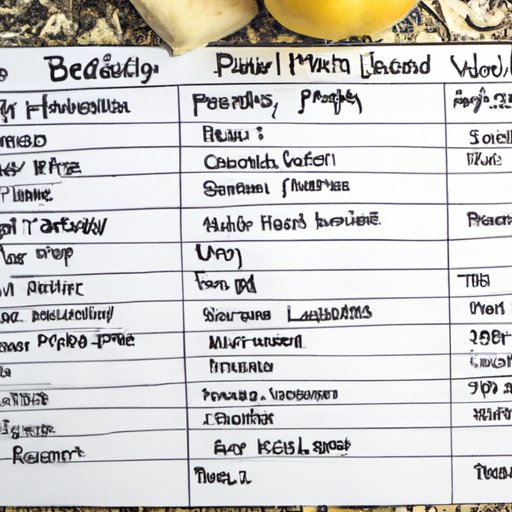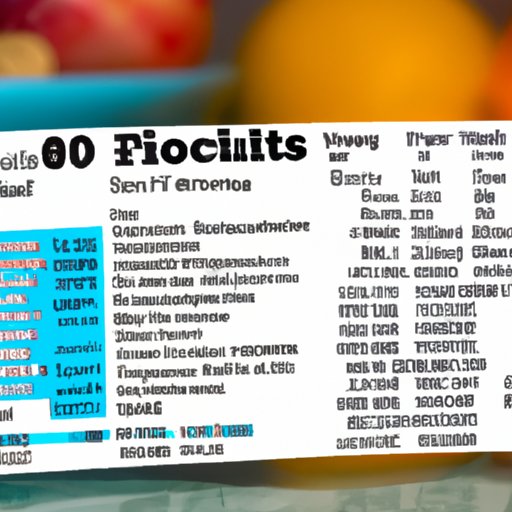Introduction
When it comes to staying healthy, what you eat plays an important role. A balanced diet is essential for providing your body with the nutrients it needs to stay fueled and functioning properly. But what is a healthy diet and how can you create one that meets your individual needs? In this article, we’ll explore the basics of what it means to eat for a healthy life.
What is a Healthy Diet?
A healthy diet includes all of the essential nutrients your body needs to stay strong and energized. This includes macronutrients like carbohydrates, proteins, and fats, as well as micronutrients like vitamins, minerals, and phytonutrients. Eating a variety of nutrient-dense foods helps ensure you get all of the essential nutrients your body needs to function optimally.

Benefits of Eating a Balanced Diet
Eating a balanced diet offers numerous benefits, including improved energy levels, better digestion, stronger immunity, and a reduced risk of chronic health conditions. Additionally, eating a healthy diet can help you maintain a healthy weight, improve your mood, and even reduce stress. All of these factors can contribute to overall mental and physical wellbeing.
Exploring the Basics of a Healthy Diet
Let’s take a look at the two main categories of nutrients you need to include in your diet: macronutrients and micronutrients.
Macronutrients
Macronutrients are the primary sources of energy for your body. They provide calories and are essential for growth and development. The three main macronutrients are carbohydrates, proteins, and fats.
Carbohydrates
Carbohydrates are found in grains, fruits, vegetables, and dairy products. They provide your body with energy and are essential for proper brain and nerve function. Complex carbohydrates, such as those found in whole grains, legumes, and starchy vegetables, are a better choice than simple carbohydrates, which are found in processed and sugary foods.
Proteins
Proteins are found in animal products, such as meat, eggs, and dairy, as well as plant-based sources, such as beans, nuts, and seeds. They help build and repair cells, as well as produce hormones and enzymes. Protein should make up 10-35% of your daily calorie intake.
Fats
Fats are found in both animal and plant sources and provide energy, help absorb fat-soluble vitamins, and support cell growth. While some fats are unhealthy, such as trans fats found in processed foods, other fats, such as monounsaturated and polyunsaturated fats found in avocados, nuts, and olive oil, are essential for good health. Fat should make up 20-35% of your daily calorie intake.
Micronutrients
Micronutrients are essential for a variety of bodily functions, from regulating hormones to building bones. The three main micronutrients are vitamins, minerals, and phytonutrients.
Vitamins
Vitamins are found in a variety of foods and are essential for growth and development. They help regulate metabolism, nerve and muscle function, and help keep your immune system strong. Vitamins are divided into two categories: fat-soluble and water-soluble. Fat-soluble vitamins, such as vitamins A, D, E, and K, are stored in the body’s fat cells. Water-soluble vitamins, such as vitamin C and the B-complex vitamins, are not stored in the body and must be consumed daily.
Minerals
Minerals are inorganic substances found in soil and water. They are essential for maintaining healthy bones and teeth, regulating body fluids, and producing hormones. Common minerals include calcium, magnesium, phosphorus, potassium, sodium, and iron.
Phytonutrients
Phytonutrients are compounds found in plants that provide health benefits. They are powerful antioxidants that can help protect against disease and promote overall health. Common phytonutrients include lycopene, lutein, and beta-carotene.

Creating a Customized Healthy Eating Plan
Now that you have a basic understanding of what it means to eat for a healthy life, you can begin to create a customized eating plan. Here are some tips to help you get started.
Understanding Your Calorie Needs
The first step in creating a healthy eating plan is to understand your calorie needs. Your calorie needs will vary depending on your age, gender, activity level, and other factors. Use an online calculator to determine your recommended daily calorie intake and use this number as a starting point when planning your meals.
Identifying Nutrient-Dense Foods
Once you know your calorie needs, you can begin to identify nutrient-dense foods to include in your diet. Focus on eating a variety of fruits, vegetables, whole grains, lean proteins, healthy fats, and low-fat dairy products. Avoid processed and sugary foods, which are high in empty calories and low in essential nutrients.

Understanding Food Labels and Nutritional Facts
Food labels and nutritional facts can help you make informed decisions about the foods you’re eating. Here’s what you need to know.
Understanding Nutrition Labels
Nutrition labels provide information about the amount of calories, fat, sodium, carbohydrates, protein, and other nutrients in a single serving size of a food or beverage. They also list any added sugars, artificial sweeteners, preservatives, and other ingredients. Use nutrition labels to compare products and choose healthier options.
Calculating Nutritional Values
Nutritional values refer to the amount of essential nutrients in a given food. These values are usually expressed as a percentage of your daily value. For example, if a food has 10% of your daily value of calcium, it means that a single serving of that food provides 10% of the calcium your body needs each day. Use nutritional values to ensure you’re getting enough of the essential nutrients your body needs.

Eating to Manage Chronic Health Conditions
Certain chronic health conditions, such as diabetes, heart disease, and high blood pressure, can be managed through diet. Here are some tips for eating to manage these conditions.
Diabetes
If you have diabetes, it’s important to focus on eating a balanced diet that is low in sugar, saturated fat, and processed foods. Aim to include plenty of fresh fruits and vegetables, lean proteins, and whole grains in your diet. Additionally, monitoring your carbohydrate intake can help you better manage your blood sugar levels.
Heart Disease
Eating a heart-healthy diet can help reduce your risk of developing heart disease. Focus on eating foods that are low in saturated fat, trans fat, and cholesterol, such as fruits, vegetables, whole grains, and lean proteins. Additionally, limiting your sodium intake can help lower your blood pressure, which can reduce your risk of heart disease.
High Blood Pressure
High blood pressure can increase your risk of stroke and heart attack. To reduce your blood pressure, focus on eating a diet that is low in salt and rich in fruits, vegetables, and whole grains. Additionally, reducing your alcohol intake and quitting smoking can help lower your blood pressure.
Strategies for Eating Healthy on a Budget
Eating healthy doesn’t have to break the bank. Here are some strategies for eating healthy on a budget.
Making Smart Shopping Choices
When shopping for groceries, look for store brands and buy in bulk when possible. Additionally, consider buying frozen fruits and vegetables, which are often cheaper than their fresh counterparts. You can also save money by buying whole chickens or roasts and using the leftovers for other meals throughout the week.
Planning Meals Ahead of Time
Planning meals ahead of time can help you stay on budget and avoid impulse purchases. Make a grocery list and stick to it. Also, try to cook large batches of food at once so you can enjoy leftovers throughout the week.
How to Incorporate Healthy Foods into Your Favorite Recipes
You don’t have to give up your favorite recipes to eat healthy. Here are some tips for incorporating healthy foods into your favorite dishes.
Substituting Ingredients
Try substituting unhealthy ingredients, such as white flour or white rice, with healthier alternatives, such as whole wheat flour or brown rice. You can also substitute ground beef with ground turkey or chicken, and full-fat dairy products with low-fat alternatives.
Adding More Vegetables
Adding more vegetables to your favorite recipes is an easy way to make them healthier. Try adding grated carrots or zucchini to lasagna, diced bell peppers to tacos, or spinach to pasta dishes. You can also add vegetables to soups and stews for a nutrient-packed meal.
Conclusion
Eating for a healthy life doesn’t have to be complicated. By understanding the basics of macronutrients and micronutrients, and following some simple strategies for eating healthy on a budget, you can create a customized eating plan that meets your individual needs. And with a few simple substitutions, you can still enjoy your favorite recipes while reaping the health benefits of a balanced diet.
To summarize, eating a healthy diet involves understanding the basics of macronutrients and micronutrients, calculating your calorie needs, and identifying nutrient-dense foods. Additionally, understanding food labels and nutritional facts can help you make informed decisions about the foods you’re eating. Finally, if you have a chronic health condition, eating a healthy diet can help you manage it. With these tips, you can start eating for a healthy life today.
(Note: Is this article not meeting your expectations? Do you have knowledge or insights to share? Unlock new opportunities and expand your reach by joining our authors team. Click Registration to join us and share your expertise with our readers.)
